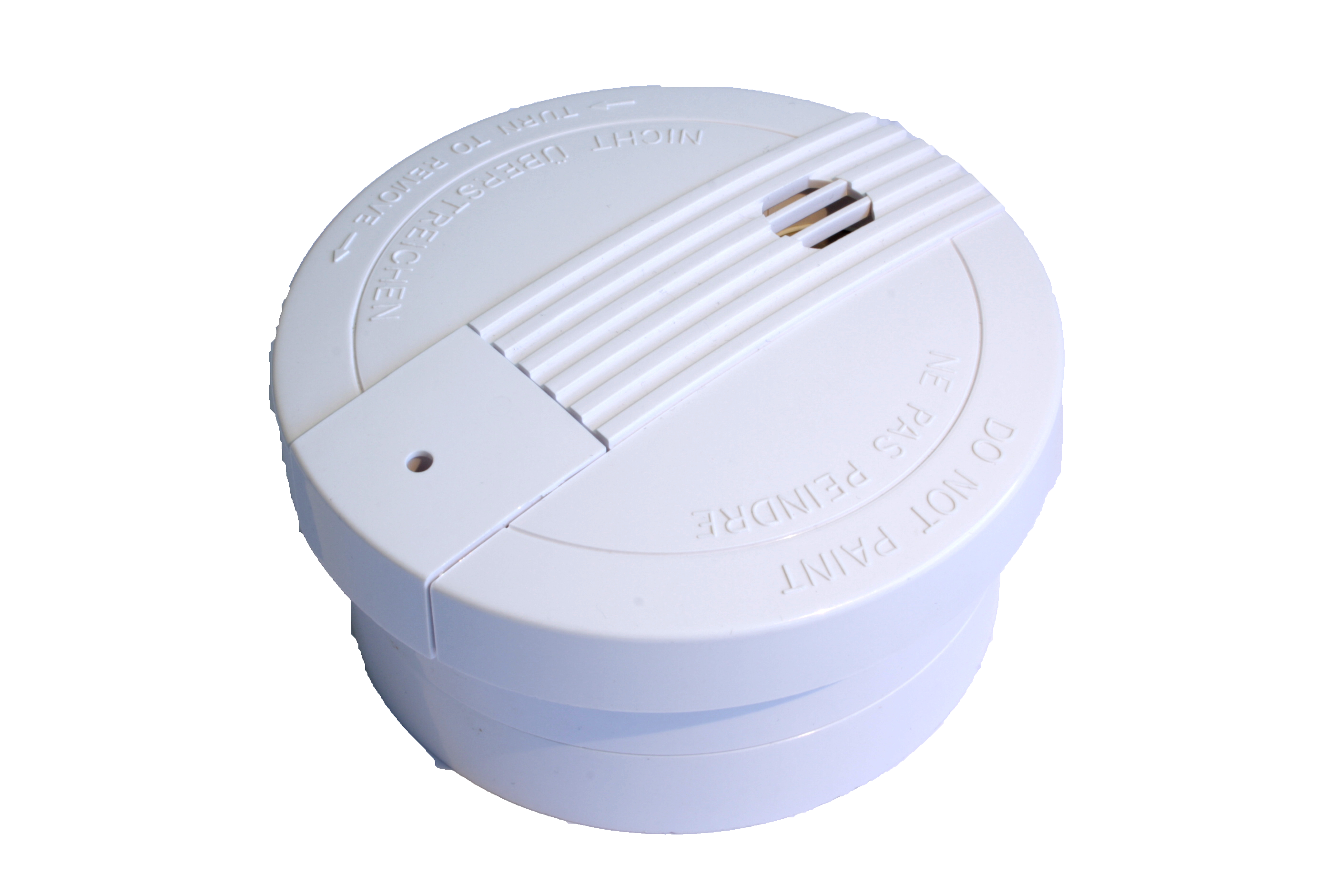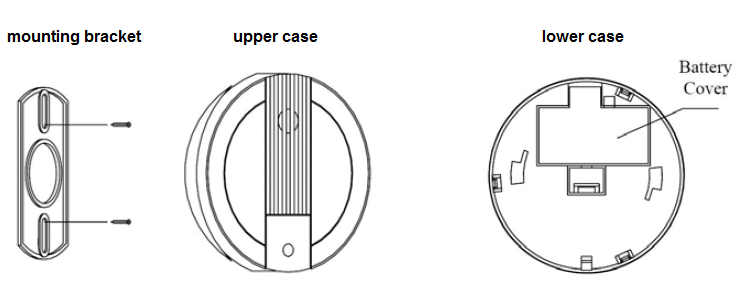
Everspring
Z-Wave Smoke Detector SF812
SKU: EVR_SF812

Quickstart
This is a
Inclusion, Exclusion and wakeup are confirmed by three times quickly hitting the binding button on the backside of the case.
Important safety information
Please read this manual carefully. Failure to follow the recommendations in this manual may be dangerous or may violate the law. The manufacturer, importer, distributor and seller shall not be liable for any loss or damage resulting from failure to comply with the instructions in this manual or any other material. Use this equipment only for its intended purpose. Follow the disposal instructions. Do not dispose of electronic equipment or batteries in a fire or near open heat sources.What is Z-Wave?
Z-Wave is the international wireless protocol for communication in the Smart Home. This device is suited for use in the region mentioned in the Quickstart section.
Z-Wave ensures a reliable communication by reconfirming every message (two-way communication) and every mains powered node can act as a repeater for other nodes (meshed network) in case the receiver is not in direct wireless range of the transmitter.
This device and every other certified Z-Wave device can be used together with any other certified Z-Wave device regardless of brand and origin as long as both are suited for the same frequency range.
If a device supports secure communication it will communicate with other devices secure as long as this device provides the same or a higher level of security. Otherwise it will automatically turn into a lower level of security to maintain backward compatibility.
For more information about Z-Wave technology, devices, white papers etc. please refer to www.z-wave.info.
Product Description
The Smoke Detector SF812 uses a non-radioactive photo-sensor for a reliable and safe detection of smoke. Simply install the Smoke Detector on your ceiling and follow the procedure in the manual. Now your room is fitted with an early warning system against smoke. The smoke detector has a test button and a flashing led, so you always know that the smoke alarm is working correctly. The smoke alarm will warn you when the battery is low. When the device detects smoke, it will give a loud warning sound. It will also trigger actions in other Z-Wave devices or Z-Wave controllers to escalate the alarm. The Smoke Detector can also activate an alarm-scenario within the Z-Wave network. For example you can create an alarm-scenario to switch on all lights in the house when smoke is detected. Even at the middle of the night, you may leave the house very quickly when smoke is detected.
Prepare for Installation / Reset
Please read the user manual before installing the product.
In order to include (add) a Z-Wave device to a network it must be in factory default state. Please make sure to reset the device into factory default. You can do this by performing an Exclusion operation as described below in the manual. Every Z-Wave controller is able to perform this operation however it is recommended to use the primary controller of the previous network to make sure the very device is excluded properly from this network.
Safety Warning for Batteries
The product contains batteries. Please remove the batteries when the device is not used. Do not mix batteries of different charging level or different brands.
Installation

- Remove the mounting bracket from the detector by rotating it counterclockwise.
- Dissolve the upper case from the lower case by rotating it in the oppsite direction and loosen the connector.
- Open the battery cover and connect the battery in the correct position.
- Fix the mounting bracket at a wall or a ceiling with the two screws.
- Link the connector to the clip in the correct position and reassemble the upper case with the lower case.
- Fix the device to the mounting bracket by rotating it clockwise.

Please follow the recommendations about amount as position of the sensor in your home as given above. Avoid to place the sensor into the angle of walls, prefer positions in the middle of the room.
Inclusion/Exclusion
On factory default the device does not belong to any Z-Wave network. The device needs to be added to an existing wireless network to communicate with the devices of this network. This process is called Inclusion.
Devices can also be removed from a network. This process is called Exclusion. Both processes are initiated by the primary controller of the Z-Wave network. This controller is turned into exclusion respective inclusion mode. Inclusion and Exclusion is then performed doing a special manual action right on the device.
Inclusion
click the inclusion/exclusion switch quickly 3 times. The LED is on when the switch is pressed.
Exclusion
click the inclusion/exclusion switch quickly 3 times. The LED is on when the switch is pressed.
Product Usage
- 1. The detector sounds as long as the test button is pressed for 3 seconds or there is smoke in the detector. When the detector goes off, always check carefully to see that there is no fire and never remove the battery from the detector except when changing it!
- 2. Always test the detector immediately after returning from holiday, after a longer period of absence or periodically to ensure the detector funtions normally. Under the test button, there is a red control LED which flashes once every 30 seconds. It indicates the detector is under normal operation. When the Smoke Detector senses smoke and simultaneously sounds an audible alarm, the red LED will flash fast. If the detector does not sound when testing, the battery must be replaced.
- 3. Never use an open flame to test your detector. You may set fire to damage the detector, as well as your home.
Node Information Frame
The Node Information Frame (NIF) is the business card of a Z-Wave device. It contains information about the device type and the technical capabilities. The inclusion and exclusion of the device is confirmed by sending out a Node Information Frame. Beside this it may be needed for certain network operations to send out a Node Information Frame. To issue a NIF execute the following action:
Hitting the inclusion/exclusion button three times will send out an Node Information Frame.
Communication to a Sleeping device (Wakeup)
This device is battery operated and turned into deep sleep state most of the time to save battery life time. Communication with the device is limited. In order to communicate with the device, a static controller C is needed in the network. This controller will maintain a mailbox for the battery operated devices and store commands that can not be received during deep sleep state. Without such a controller, communication may become impossible and/or the battery life time is significantly decreased.
This device will wakeup regularly and announce the wakeup state by sending out a so called Wakeup Notification. The controller can then empty the mailbox. Therefore, the device needs to be configured with the desired wakeup interval and the node ID of the controller. If the device was included by a static controller this controller will usually perform all necessary configurations. The wakeup interval is a tradeoff between maximal battery life time and the desired responses of the device. To wakeup the device please perform the following action:
Tripple click on the inclusion/exclusion button will wake up the device and keep it awake for 5 seconds.
Quick trouble shooting
Here are a few hints for network installation if things dont work as expected.
- Make sure a device is in factory reset state before including. In doubt exclude before include.
- If inclusion still fails, check if both devices use the same frequency.
- Remove all dead devices from associations. Otherwise you will see severe delays.
- Never use sleeping battery devices without a central controller.
- Dont poll FLIRS devices.
- Make sure to have enough mains powered device to benefit from the meshing
Association - one device controls an other device
Z-Wave devices control other Z-Wave devices. The relationship between one device controlling another device is called association. In order to control a different device, the controlling device needs to maintain a list of devices that will receive controlling commands. These lists are called association groups and they are always related to certain events (e.g. button pressed, sensor triggers, ...). In case the event happens all devices stored in the respective association group will receive the same wireless command wireless command, typically a 'Basic Set' Command.
Association Groups:
| Group Number | Maximum Nodes | Description |
|---|---|---|
| 1 | 5 | Devices to be informed about alarms |
Technical Data
| Dimensions | 0.1020000x0.1020000x0.0500000 mm |
| Weight | 180 gr |
| Hardware Platform | ZM3102 |
| Battery Type | 1 * 9V Block |
| Firmware Version | 01.04 |
| Z-Wave Version | 02.40 |
| Certification ID | ZC08-09070013 |
| Z-Wave Product Id | 0060.000d.0001 |
| Frequency | Europe - 868,4 Mhz |
| Maximum transmission power | 5 mW |
Supported Command Classes
- Basic
- Battery
- Association
- Version
- Manufacturer Specific
- Sensor Alarm
- Alarm
Controlled Command Classes
- Alarm
Explanation of Z-Wave specific terms
- Controller — is a Z-Wave device with capabilities to manage the network. Controllers are typically Gateways,Remote Controls or battery operated wall controllers.
- Slave — is a Z-Wave device without capabilities to manage the network. Slaves can be sensors, actuators and even remote controls.
- Primary Controller — is the central organizer of the network. It must be a controller. There can be only one primary controller in a Z-Wave network.
- Inclusion — is the process of adding new Z-Wave devices into a network.
- Exclusion — is the process of removing Z-Wave devices from the network.
- Association — is a control relationship between a controlling device and a controlled device.
- Wakeup Notification — is a special wireless message issued by a Z-Wave device to announces that is able to communicate.
- Node Information Frame — is a special wireless message issued by a Z-Wave device to announce its capabilities and functions.